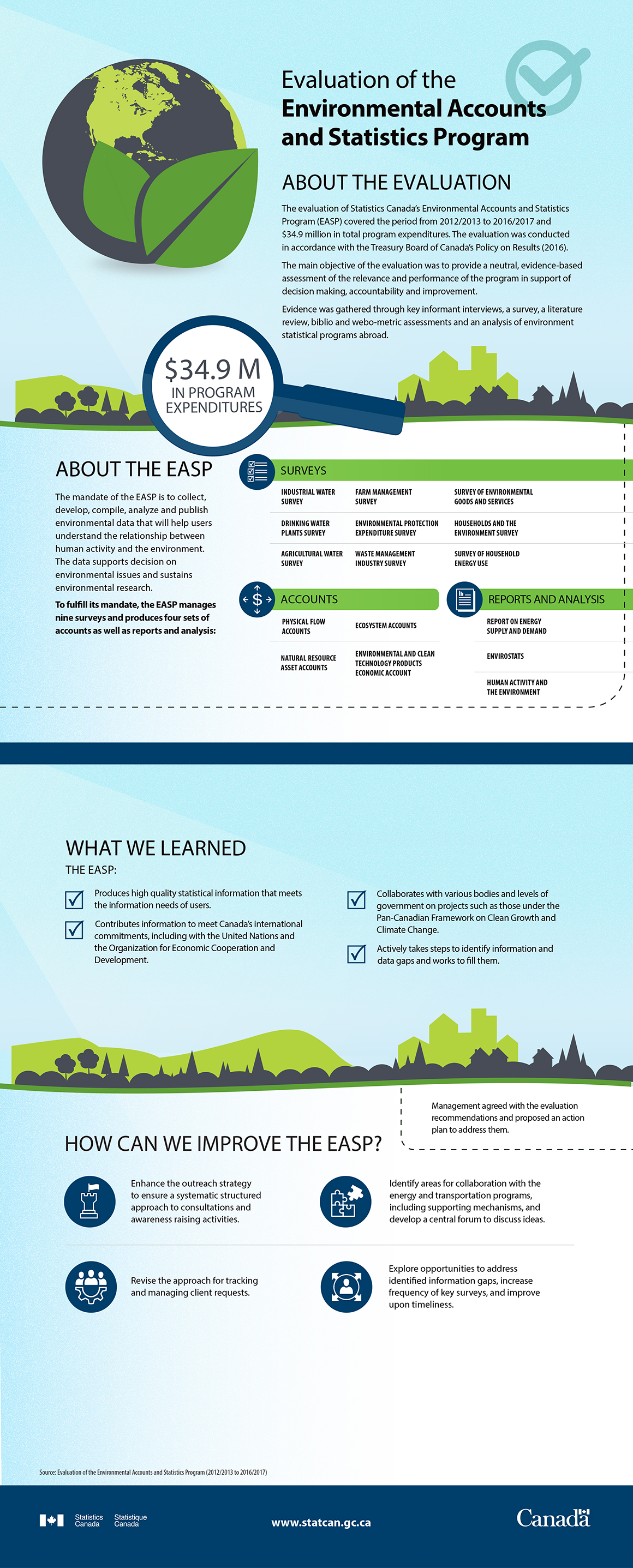
Description - Evaluation of the Environmental Accounts and Statistics Program - Information Sheet
Evaluation of the Environmental Accounts and Statistics Program - Information Sheet
About the evaluation
The evaluation of Statistics Canada’s Environmental Accounts and Statistics Program (EASP) covered the period from 2012/2013 to 2016/2017 and $34.9 million in total program expenditures. The evaluation was conducted in accordance with the Treasury Board of Canada’s Policy on Results (2016).
The main objective of the evaluation was to provide a neutral, evidence-based assessment of the relevance and performance of the program in support of decision making, accountability and improvement.
Evidence was gathered through key informant interviews, a survey, a literature review, biblio and webo-metric assessments and an analysis of environment statistical programs abroad.
A magnifying glass appears with the text: $34.9 M in program expenditures
About the EASP
The mandate of the EASP is to collect, develop, compile, analyze and publish environmental data that will help users understand the relationship between human activity and the environment. The data supports decision on environmental issues and sustains environmental research.
To fulfill its mandate, the EASP manages nine surveys and produces four sets of accounts as well as reports and analysis:
- Surveys:
- Industrial Water Survey
- Farm Management Survey
- Survey of Environmental Goods and Services
- Drinking Water Plants Survey
- Environmental Protection Expenditure Survey
- Households and the Environment Survey
- Agricultural Water Survey
- Waste Management Industry Survey
- Survey of Household Energy Use
- Accounts:
- Physical Flow Accounts
- Ecosystem Accounts
- Natural Resource Asset Accounts
- Environmental and Clean Technology Products Economic Account
- Reports and Analysis:
- Report on Energy Supply and Demand
- Envirostats
- Human Activity and the Environment
What we learned
The EASP:
- Produces high quality statistical information that meets the information needs of users.
- Contributes information to meet Canada’s international commitments, including with the United Nations and the Organization for Economic Cooperation and Development.
- Collaborates with various bodies and levels of government on projects such as those under the Pan-Canadian Framework on Clean Growth and Climate Change.
- Actively takes steps to identify information and data gaps and works to fill them.
How can we improve the EASP?
- Enhance the outreach strategy to ensure a systematic structured approach to consultations and awareness raising activities.
- Identify areas for collaboration with the energy and transportation programs, including supporting mechanisms, and develop a central forum to discuss ideas.
- Revise the approach for tracking and managing client requests.
- Explore opportunities to address identified information gaps, increase frequency of key surveys, and improve upon timeliness.
Management agreed with the evaluation recommendations and proposed an action plan to address them.
Source: Evaluation of the Environmental Accounts and Statistics Program (2012/2013 to 2016/2017).